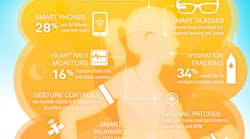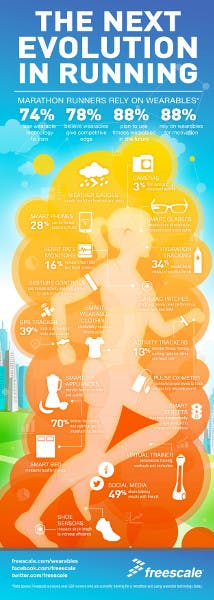Wearable tech is all the rage these days but there are significant challenges in packaging, power and, of course, micros (see “Wearable Technologies Present Packaging Challenges”). It can be used for a range of applications such as marathon runners (Fig. 1) and much more.
I spoke with Sujata Neidig, Consumer Business Development Manager for Freescale's Microcontroller division, about wearable tech and Freescale's WaRP (see “It Takes A WaRPed Mind To Design Wearable Tech”). This compact platform can be used as the basis for wearable tech development.
Wong: Where does Freescale think wearable computing is headed?
Sujata: From Freescale’s experience in the consumer market, we saw momentum in the wearable computing segment that’s driven by consumer demand as well as technology enablers. The market is evolving very quickly and manufacturers of wearable devices are developing solutions that address the key requirements consumers have: small, long battery life and the right experience or usability – simple and meaningful. We see wearable devices being integrated into people’s daily lives as a way of improving their lifestyle – from fitness to personal healthcare to infotainment and entertainment. Because of this, we see the wearable segment addressing multiple vertical applications that will each contribute to the rapid growth expected.
Wong: You recently did a survey about wearable technology of runners training for the marathon. What were the results?
Sujata: The survey conducted was focused on runners training for a marathon. While you might not have been surprised by the overwhelming numbers of people using wearables (74% use wearables to train), what was really interesting was the interrelationship that people have with their devices. 88% of people surveyed said they rely on wearables for motivation similar to a coach, and 78% believe wearables give them a competitive edge. In addition, 88% plan to use fitness wearables in the future.
Related Articles
- It Takes A WaRPed Mind To Design Wearable Tech
- Gallery: Wearable Tech at CES 2014
- Wearable Technologies Present Packaging Challenges
Wong: How do you think these results compare to the general public?
Sujata: This survey was specifically targeted at runners and translates very well to the general public of runners. If you’re a runner, you’ll see that most other runners rely on some type of wearable device to help with their training, keep them motivated and accomplish their running/fitness goals. This is also evident in the popularity and growth in running watches seen by companies like Garmin. Garmin recently announced their earnings report which showed strong growth. A large part of that growth was attributed to the Fitness line of Forerunner running watches which saw a 14% growth.
Wong: What kind of technology does Freescale offer in this area?
Sujata: Freescale offers processors/controllers and sensors to enable the wearables market. With our broad portfolio of ARM-based microcontrollers and microprocessors, we provide the right solution for all tiers of wearable devices. Our product portfolio includes small Cortex-M0+ MCUs for sensor hub or single function applications (such as pedometers), mid-range Cortex-M4 MCUs for more advanced activity monitors or smart watches and Cortex-A9 applications processors for wearable devices that require multi-functional capabilities with rich user interfaces. We continue to provide higher levels of integration enabling and smaller more advanced packaging to address the need for small form factors of wearables. We also continue to drive our portfolio to lower power capabilities through implementation of low-power architectures and designs which provide longer battery life in an end application. To complement our controllers and processors, we also create sensors with intelligence which are a critical component of wearable devices in collecting environmental data that can then be processed, analyzed and used by the consumer.
Wong: What’s a specific example of something Freescale is doing to address the wearables market?
Sujata: Freescale is working with our ecosystem and enabling a reference platform targeted at the wearable market. WaRP was announced at CES and will launch in 2nd quarter of this year. This reference platform does the hard work of creating the building blocks needed for a wearable computing platform and implements a hybrid architecture. The hybrid architecture means there is an advanced processor used as the guts of the wearable platform to manage connectivity, the user interface and basic sensing. To complement this capability, the hybrid architecture is expandable to address different usage models by supporting add-on modules such as a sensor hub and wireless charging board based on a low-power and small form factor MCU. WaRP is based on Android and will be an open-source platform supported by a community of developers at WaRPboard.org so that it can evolve as the market evolves.

